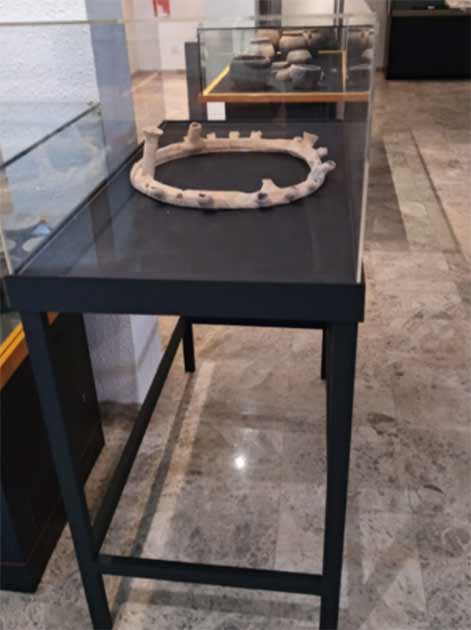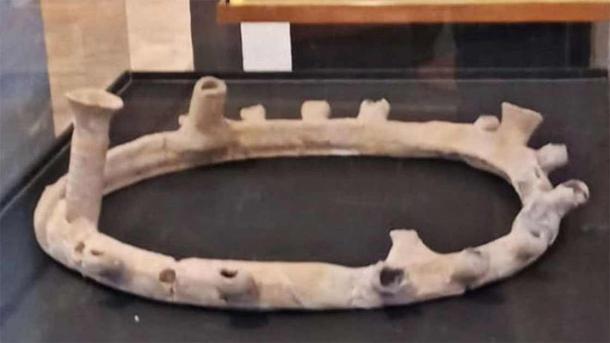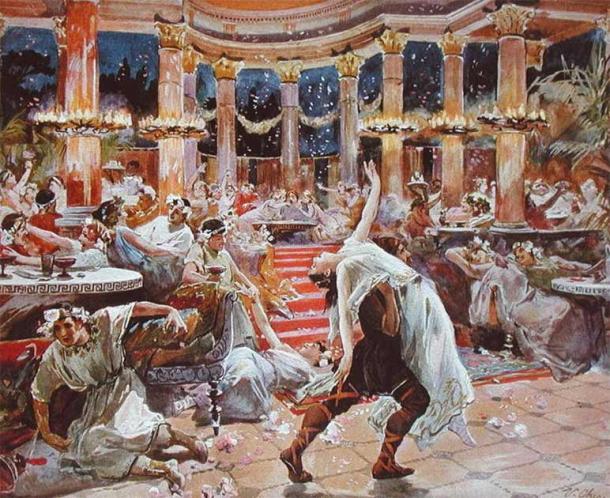An exceptionally rare, 2,000-year-old Roman-era chandelier has been unearthed at an archeological dig in Spain’s Elda Valley. The now preserved ancient artifact once swung from the ceiling of a large social space providing light to opulent Roman parties and lush banquets. Last lit in the 1st century AD, the round lamp has a half meter diameter and holders for 32 candles.

Eva Maria Mendiola, who respectfully restored the light, told The Times that before it was put on display at the Elda Museum in Alicante, Spain, researchers were able to learn volumes about its origins. Perhaps most importantly, the restorers found the name “Lucius Eros” branded on other artifacts that were discovered with the chandelier – the name of the Roman-era craftsman who hand crafted the light.

The rare Roman chandelier, restored by local art teacher Eva Maria Mendiola, is on display at the Elda Museum in Alicante, Spain. (Museo Arqueológico Municipal de Elda)
Roman Chandelier Puts a Spotlight on Ancient Life
The chandelier was discovered at the Iberian-Roman settlement and now archaeological site of El Monastil near Elda. An article in Daily Mail describes the “last remaining Roman chandelier” as the first of its kind to have been discovered in such a good state of preservation. The light functioned when fuses were inserted through its holes and lit, as oil was piped in to keep the lamps alight.
- Valeria: Thriving Roman Holiday Resort Emerging From Abandoned Ruins
- 1,500-year-old Visigoth Sarcophagus Found at Roman Villa Site
A 2012 article in Information ES explains that the site of El Monastil was first discovered in 1989. This news piece announced that archaeologists had discovered a 2,000-year-old Roman staircase. Furthermore, kilns discovered at El Monastil are still considered to be “the first industrial factory of Elda Valley.”

The circular Roman ceramic chandelier has a diameter of half a meter and supported 32 candles or fuses. (Museo Arqueológico Municipal de Elda)
While these 2,000-year-old ovens are indeed old, both Neolithic and Bronze Age cultures also used kilns long before the Roman era. At the peñón del Trinitario archaeological site on the slopes of Mount Bolón, for example. Kilns, torches and oil lamps were also used by Orientalizing, Iberian, Byzantine, Visigothic and Islamic cultures, who all inhabited the Elda valley.
However, to get to the origins of the iconic swinging chandelier, an artifact symbolic of excess, riches and opulence, we must reach way back before the Neolithic. According to Lights Online , archaeologists have discovered three separate types of oil and grease lamps that would have been hung in caves (chandeliers) dating back to 17,000 BC. Furthermore, small holes were identified in the walls of the Lascaux caves in France that were used to hang torches around 15,000 BC, so that the people could see in the dark to make their now famous cave paintings.

20th century depiction of a Roman banquet lit by chandeliers. ( Public domain )
Exporting Roman Chandeliers and Party Lights to Distant Elites
Getting back to the story, by the Roman-Iberian period chandeliers were used to illuminate large social spaces. While the elites of Roman Spain enjoyed the very best foods and wines at their parties and banquets, an entire social structure existed to keep them drunk, to make sure they kept paying for luxury foods and items they really didn’t need.
“Excess” was the name of the game, and at El Monastil one man who knew this well was Lucius Eros, whose name was discovered marked on four light molds at the site, right beside the chandelier. According to Spanish daily El Pais , in 1989 Antonio M. Poveda, professor of Ancient History at the University of Alcalá de Henares, explained that chandeliers of this style would have “taken a lot of expertise to make.”
Such lights were made and exported to elite Romans in distant cities of the Roman Empire . It appears that excavations at El Monastil discovered the workshop of the potter Lucius Eros, as fragments of other chandeliers were also found at the site. “The archaeologist believes that Lucius’ workshop would mainly receive orders from large nearby cities, such as Ilici (now Elche) or Lucentum (now Alicante),” highlights El Pais . The rare Roman artifact, which has been brilliantly restored by local art teacher Eva Maria Mendiola, is now on display at the Elda Museum in Alicante, Spain.





